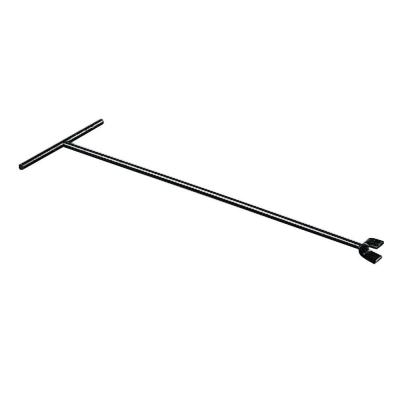In case of a flood emergency where a pipe bursts and your home is starting to fill with water, it helps to know:
- Where your shut off valve is (usually outside, with a heavy iron cover over it)
- How to turn it off.
In the case of No. 2, the valve requires a curb key (also known as a water key), which you can purchase from you local hardware store, Home Depot or Lowe’s. They look like this:

You can also use a wrench but the key makes things a lot easier.
A pipe burst emergency is every homeowner’s nightmare. Water damage can escalate quickly, leading to expensive repairs and potentially ruining your belongings. Thankfully, with the right knowledge, you can minimize the damage and protect your home. One essential skill every homeowner needs is knowing how to turn off the water in case of such an emergency. Here’s how you can prepare and respond effectively.
Step 1: Know the Location of Your Shut Off Valve
When a pipe bursts, the first and most important action is to stop the water flow at its source. This means turning off your main water shut-off valve. For most homes, this valve is located outside, often near the edge of your property, covered by a heavy iron lid. Take some time now to locate this valve, so you aren’t scrambling if an emergency arises.
Step 2: Learn How to Turn Off the Shut Off Valve
Once you’ve located your shut-off valve, the next step is knowing how to turn it off. The shut-off valve typically requires a tool called a curb key (also known as a water key). This tool simplifies the process and makes turning the valve easier, even under stressful situations. If you don’t already own one, you can purchase a curb key at stores like Home Depot or Lowe’s.
If a curb key isn’t available, a sturdy wrench might work as an alternative, but it can be trickier to handle. Having the right tool on hand is always recommended for quick and efficient action.
Step 3: Take Preventative Measures
While knowing how to shut off your water is essential, prevention is just as important. Protect your home by following these simple tips:
- Monitor Water Pipes: Regularly check for any signs of wear, leaks, or corrosion on your pipes.
- Insulate Pipes in Winter: Use insulation to prevent freezing, as frozen pipes are one of the leading causes of bursts.
- Keep Tools Accessible: Store your curb key or wrench in a place you can easily find during an emergency.
Why Acting Fast Matters
A pipe burst emergency can lead to extensive water damage, including soaked flooring, damaged walls, and potential mold growth. The quicker you stop the water flow, the lower your repair costs and the less hazard to your family’s health.
Get Professional Help When Needed
While turning off the water can stop an immediate crisis, the damage might require professional restoration. This is where experts Blue Chip Restoration come in. Our team specializes in water damage repair and restoration, ensuring your home is dry, safe, and back to normal. From minor repairs to large-scale cleanup, we have you covered.
Be Prepared for the Unexpected
Emergencies can happen anytime, so being prepared is key. By knowing the location of your shut-off valve and having a curb key at the ready, you’ll save precious time and minimize damage. Don’t wait for a disaster to strike—take these steps today and protect your home from costly water damage.
For more assistance with water damage prevention or restoration, contact Blue Chip Restoration—Nashville’s trusted professionals in disaster recovery. With 24/7 emergency services, we’re here when you need us most.